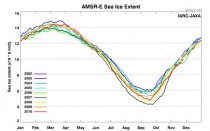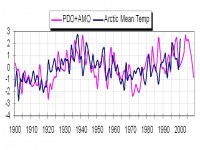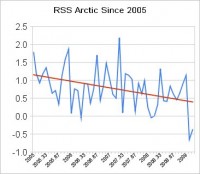As Anthony Watts reported here, NASA GISS now points to aerosols as the cause of recent anomalous arctic warming.
Since the 1890s, surface temperatures on Earth have risen faster in the Arctic than in other regions of the world. Usually, discussions on global warming tend to focus on greenhouse gases as the culprit for the trend. But new NASA research suggests about half the atmospheric warming measured in the Arctic is due to airborne particles called aerosols.
Aerosols are emitted by both natural and human sources. They can influence climate by reflecting or absorbing sunlight. The particles also affect climate by changing cloud properties, such as reflectivity. There is one type of aerosol that, according to the study, [reduces] rather than increases in its emissions seem to have promoted warming.
The research team, led by climate scientist Drew Shindell of the NASA Goddard Institute for Space Studies used a computer model to investigate how sensitive different regional climates are to changes in levels of carbon dioxide, ozone, and aerosols.
They found that Earth’s middle and high latitudes are particularly responsive to changes in aerosol levels. The model suggests aerosols likely account for 45 % or more of the warming measured in the Arctic since 1976.
Though there are several types of aerosols, previous research indicates two in particular, sulfates and black carbon, play leading roles in climate. Both are products of human activity. Sulfates, which come mainly from the burning of coal and oil, scatter sunlight and cool the air. Over the past three decades, the United States and European countries have passed clean-air laws that have halved sulfate emissions.

See larger image here.
Since the 1890s, surface temperatures have risen faster in the Arctic than in other regions of the world. In part, these rapid changes could be due to changes in aerosol levels. Clean air regulations passed in the 1970s, for example, have likely accelerated warming by diminishing the cooling effect of sulfates. Credit: Drew Shindell, Goddard Institute for Space Studies.
The models showed that regions of Earth that showed the strongest responses to aerosols in the model are the same regions that have witnessed the greatest actual temperature increases since 1976, specifically the Arctic. However in the Antarctic, aerosols play less of a role. Read more here.
Icecap Notes: This is a another attempt to blame man and our evil ways for the natural changes we see in the arctic. If not CO2, then carbon soot or aerosols. Willie Soon in 2004 showed how well arctic basin temperatures (Polyakov) correlated with total solar irradiance (Hoyt/Schatten) and how poorly it correlated with CO2.

See larger image here
I have found the Atlantic and Pacific temperature cycles (PDO and AMO) also matched very well with the arctic temperatures as shown below. Water intrudes into the arctic beneath the ice through the Bering Straits or the North Atlantic near the Barents Sea. When the water is unusually warm, there is more melting, cold less.

See larger image here
Both Willie and I used the Polyakov data set for the arctic basin available to 2000. Craig Loehle has shown how the RSS satellite analysis of the arctic shows a cooling since 2005, consistent with the global trend.

See larger image here
How does their model explain this? You must understand there is an effort to discount any natural factors from influencing climate or the crack in the dyke that would create could open up the theory to increasing questions, more holes in the dyke than they have fingers or model answers to fill. With every new model explanation, they sound less convincing, more desperate.




